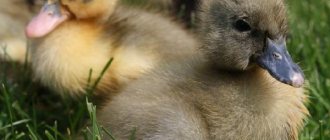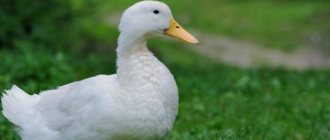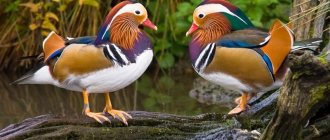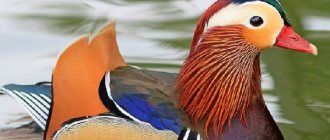How to distinguish a male from a female
Today you can find many tips on how to recognize a drake and a duck. But when it comes to practical application, it becomes clear that there are not so many of these signs.
The most difficult place to look for males and females is among the ducklings. It is necessary to distinguish chicks by sex, since it is necessary to correctly select the sex ratio in the agricultural population.
The ideal proportions when raising birds for meat or for obtaining eggs vary somewhat. However, choosing them correctly will help achieve maximum efficiency.
The most accurate methods are the following recognition methods.
By appearance
The main visual differences between drakes and ducks are as follows:
- males have brighter plumage than females, which most often have a gray, dull color;
- males are always larger than females;
- males usually have a wide forehead in the shape of a triangle, females have a thinner forehead with smooth outlines, more like a trapezoid in shape;
- males have a small crest on the neck;
- In males, the tip of the tail is rounded; the tail of ducks is almost always straight;
- males have a larger beak;
- drakes are decorated with a feathery beard.
By voice
It is worth paying attention to the sounds that birds make. Ducks usually quack, while drakes mainly hiss. Moreover, the female’s voice is always louder (this is how she attracts ducklings), and the male’s voice can be heard extremely rarely.
By genitals
Unlike other birds, drakes have anatomical differences from ducks. It is in males that the large penis is located in the walls of the cloaca. It may not be immediately noticeable, although it is quite impressive in size.
During nesting or mating season, the genital organ can turn outward, although it is this advantage that seriously complicates the life of the bird, because its length is sometimes equal to the length of the body itself.
Differences between ducks and drakes by genitals
Differences between a duck and a drake (video)
Sexual characteristics at an early age
With ducklings the situation is somewhat different. Only after 2-3 months can you see the differences. On farms, ultrasound is used to separate ducklings. Only individuals of one sex react to a certain frequency, while others are afraid of the signals and try to hide. This method is used to distinguish females from males and place them in different cages.
Attention should also be paid to the sounds that the bird makes. The female usually produces a quack, while the drake usually produces only a hiss.
Mallard duck offspring can be turned upside down. If the duckling looks back, it will be a male, and the female will simply hang there motionless. Behavioral aspects are very important, but it is worth taking into account their certain subjectivity. For example, the leader drake is visible already at an early age: he fights, does not allow other males to approach the “girls”, makes more noise than others, that is, he tries in every possible way to stand out.
Habits of males
In a group of ducks, you can see that the females do not try to be leaders at all: they always stay either somewhere to the side or behind. Moreover, this rule is observed not only while walking, but also in flight.
Often, even when breeding poultry, aggressiveness on the part of drakes is noted. They often start fights over females or food.
Apart from the fact that drakes fertilize females, they have no other significance in nature. From a practical point of view, they have healthy, tasty meat and warm fluff, which is used to make clothing.
In Peking ducks, the drake has curls at the tip of its tail, the duck does not.
External features of the drake
You can determine the sex of ducks by their appearance. The main differences between a male and a female:
- Color. Drakes have a bright and eye-catching color. Ducks cannot boast of such things. Their plumage is gray-brown. Males need to stand out to attract the attention of "ladies". For females, inconspicuous plumage is extremely necessary, because they must hatch eggs. These birds usually make nests in thickets of reeds and other coastal plants. The gray-brown duck is difficult to see in them. As we see, in nature everything is clearly thought out.
- Size. Drakes are often larger than ducks. They have a wider chest and a much more powerful neck. This is also easy to explain. Females are peaceful creatures. Males often engage in fights for their mates.
- Feathers on the tail. In females they are straight. Males have more curved tail feathers. Scientists cannot yet explain the reason for this difference.
- Behavior. From childhood, drakes behave more aggressively towards other male ducks. They often start fights, seeing other young males as potential rivals. Females do not participate in fights. When males fight, they often retreat into a corner or move away.
- Sounds. Everyone is accustomed to hearing the characteristic quack of ducks. In fact, only females make such sounds. From drakes (remember, this is the name of a male duck) you can only hear a hissing sound.
How to choose a male for the tribe
Correct determination of gender will allow you to correctly determine the feed and choose the direction of development of the poultry house. In order to choose a good drake, you should consider its structure.
It is desirable that the bird meets the following parameters:
- flat, wide, without curvature, the keel should be parallel to the ground;
- the chick must be healthy - healthy drakes behave noisily, actively, their plumage near the cloaca is clean and dry;
- You only need to purchase individuals over 7 days old - by this age the ducklings have time to get stronger.
How to distinguish a drake from a duck: video
Duck
- a representative of birds from several genera of the Anatidae family: shelducks, diving ducks (pochards), white-headed ducks, dabbling ducks, steamer ducks, musky ducks and mergansers; in total more than 110 species. Ducks are widespread; there are more than 30 species in Russia.
Male ducks are called drakes
, duck chicks are
ducklings
.
The word duck
comes from other Russian.
uty
(cf. Ukrainian
utitsya
), from Proto-Slavic *
ǫtь
or *
ǫty
(cf. Tslav.
ѫty
, Serbo-Croatian
ȕtva
, Slovenian
ọ̑tva
, N.-Luśnica
huśica
).
At the Indo-European level, it is related to Lit. ántis
"duck", Old Prussian.
antis
, other Indian
ātíṣ
“water bird”, lat.
anas
, doctor of historical sciences
anut
"duck", Greek
νῆσσα
[1] .
Ducks are birds of medium and small size with a relatively short neck and a tarsus covered in front with transverse scutes. The color of the plumage is varied; many species have a special “mirror” on the wing. A number of species are characterized by pronounced sexual dimorphism during the breeding season, most often manifested in different colors of the plumage of the male and female. Most species moult twice a year; summer - full, autumn - partial.
Domestic ducks are descended from the mallard. Drakes of domestic ducks weigh 3-4 kg, ducks - 2-3.5 kg. The average annual egg production is up to 250 eggs. Breeds of domestic ducks are divided into meat (Peking, gray Ukrainian, black white-breasted), meat and egg (mirror, khaki Campbell), egg (Indian runners). Ducks are bred in many countries, including Russia.
Let's talk about what a male duck is called. Boy birds play an important role in reproduction by fertilizing girl birds. In addition, they care for and protect the offspring and the female that incubates them. Hatched ducklings can also count on the help of their father, at least in the first days after birth. Males are distinguished by their appearance, behavior and size. The quantity and quality of the new duck stock depends on the choice of the manufacturer. Details in the article.
Characteristic
A boy duck is called a drake. It will not be difficult to distinguish it from a duck if you use the methods described in the article “How can you distinguish a duck from a drake.”
The male duck has an important difference from the female - a spiral-shaped genital organ with a length of 1.5 to 3-4 millimeters, depending on age.
When excited, it increases in size, sometimes equaling the length of the body. This feature complicates the life of drakes, making it difficult to fly and move on water or land.
The male duck has other distinctive features:
- Bright plumage color. During the mating season, it becomes even brighter - this helps the drakes attract females for mating.
- The body of males is larger than that of females. The weight of a wild male reaches 2-4 kg, a domestic one - 5-6 kg.
- A long neck with a crest of a brighter color than the rest of the plumage.
- The head has a wide forehead, the beak is triangular in shape, and has a beard.
- Some drakes have "curls" at the tip of their tail.
- The behavior is dominant, sometimes aggressive. Males are capable of starting a fight for a female or food.
What is the difference between a male and a female. Photo of drake and duck
Determining the sex of a bird can be quite difficult, especially if the hunter does not have special knowledge, much less experience in this area. This recommendation also applies to waterfowl. Many varieties of ducks do not have sufficiently pronounced features that can quickly and accurately indicate their gender. Therefore, to help all novice poultry farmers, experts offer several important characteristics. It is thanks to them that you can easily distinguish a male from a female. For example, the photos of a drake and a duck included in this article allow you to clearly see the differences in the colors of the birds from each other. Appearance is the main feature by which you can distinguish them from each other.
Differences between domestic and wild birds
The behavior of males changes based on their habitat - whether they live at home or live in wild places.
In nature, drakes protect nests where females hatch eggs from attacks by predators: birds, foxes, martens, and snakes. There is no such need in a home environment.
House drakes are trusting and are not afraid to approach people. Certain species of wild birds, for example, mallards, also approach humans. However, for them it sometimes ends in failure. Due to the extermination of ducks by people for fun or food, some wild species are on the verge of extinction .
The feeding habits of domestic and wild birds are not very different. However, domesticated ducks do not have to search for food around the clock - they are fed by the owner. On the other hand, they are able to feed on their own, like wild males: crustaceans, grass, duckweed and other food found in pastures and reservoirs.
Description of wild males
The wigeon has a light body and a head with brown plumage. Males are cautious, timid, often hide in reeds and other secluded places, and fly quickly. Therefore, hunting them is difficult and challenging for hunters. You will find more information in the article “About the wigeon duck: description of the bird.”
Teal have several subspecies: cracker, whistler, kloktun, marbled and others. In autumn, the drakes become the usual brown color, like the females. You can learn more about this species of wild duck in the article “About the Teal Duck.”
From wild to domestic
The mallard is a common species of wild duck. Drakes have bright plumage with a white stripe on the neck. They are careless and naive, making them easy targets for hunters. Male and female mallards have long been kept indoors. The features of their domestication can be found in the article “On breeds and types of wild ducks.”
Indo-duck is also called musk duck due to the secretion of fat with a musky aroma. Drakes of this breed are heavy, unpretentious, and rarely make sounds. Another feature of males is their strong immunity. They live long and rarely get sick.
Peking ducks are often kept on private farms. The males of this breed are similar in color to the females. They can be distinguished by their weight: drakes reach a mass of 4 kilos, while ducks weigh no more than 3.5 kilos. In addition, boys are more restless than girls, and often conflict with “competitors.” Other common domestic breeds are described in the article “About Domestic Ducks.”
What is the name of a male duck, and how can you tell it apart from a female?
In many animals and birds, determining the sex of an individual is quite simple by color, unique characteristics or habits.
Adult ducks are one of them. However, among small ducklings it is extremely difficult to determine where the “boy” or “girl” is. Many people try to distinguish male and female ducklings when purchasing. However, this is rarely possible. Many people call birds of either sex ducks. However, this is not entirely correct. Let's look at what a male duck is called. We will also try to explain the etymology of this word.
Selecting a drake for a tribe
With the right choice of breeding drake of an Indian duck, Pekingese or any other breed, you can count on getting strong and healthy offspring.
Males play an important role in the household. Starting from fertilization of females to obtaining fresh, healthy meat and warm fluff. When choosing drakes for your tribe, be guided by the following parameters:
- The chick's body must have the correct proportions - a straight keel without curvature.
- Healthy males are active and noisy. It is not recommended to take lethargic or aggressive birds.
- It is better to choose week-old drakes - by this time they will get stronger and show character.
Do not forget about the ratio in the duck tribe: for every three females there is one drake. The distribution of food and living conditions depend directly on the number of drakes in the household.
We hope that the information presented was useful to you. We will be grateful for your like and repost. Leave comments and check out our other articles.
- Author: Maria Sukhorukikh
Rate this article:
- 5
- 4
- 3
- 2
- 1
(0 votes, average: 0 out of 5)
Share with your friends!











